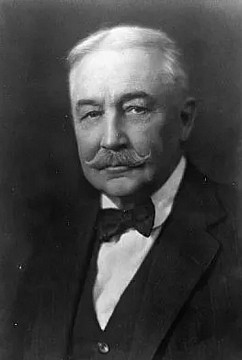John Cleveland Osgood (1851-1926)
Coal Baron of Redstone, Colorado; Founder of the Colorado Fuel & Iron Company
He was born at Brooklyn, New York, and was a great-grandson of Samuel Osgood, 1st U.S. Postmaster-General and 1st President of the City Bank of New York whose townhouse served as the new Republic's first Presidential mansion. Despite his roots, John was orphaned in Providence by the age of eleven and having been handed around various relatives he dropped out of school at fourteen. Coming to New York, he took night classes at the Cooper Institute and graduated with a degree in accounting in 1870. By 1878, he was in the employ of the First National Bank in Ottumwa, Iowa, when he got his break, acquiring and becoming President of the financially strained Whitebreast Coal & Mining Co., a major coal supplier for the Chicago, Burlington & Quincy Railroad. In 1882, the railroad sent Osgood to Colorado to source a new coal supply for their locomotives. On striking 'black gold,' he established the Colorado Fuel Company and on bringing in friends from Ottumwa they became known as "the Iowa Group".
Osgood's biographer, Sylvia Ruland, described him as, "ambitious, indomitable, ruthless, and so single-minded that he believed nothing was impossible. With the daring and cunning of a Mississippi gambler, he acquired the art of corporate manipulation and had the ability to convince others that his judgment was infallible. He took little advice and gave fewer explanations." In 1887, he merged with the Colorado Iron Company and in 1892 formed the Colorado Fuel & Iron Company (CF&I), the largest concern of its kind in the state. He established new headquarters at the Bessemer ironworks, built 249 coke ovens, and laid out the Crystal River Railroad to transport the coal and coke to the foundries at Pueblo. His longest lasting legacy is the company town he laid out, Redstone, that was called, "the ruby of the Rockies," and where he built "Cleveholm" in 1899, his modern, very American 42-room mansion where he entertained both John D. Rockefellers, J.P. Morgan, George Gould, Theodore Roosevelt, and the Belgian Prince Henri de Croy.
He was the wealthiest and most influential coal baron of his era in Colorado. But, desperate to his expand his steel mills, he issued stocks and bonds to cover company debts and attempted to form an alliance with railroad interests, making a pact with George Gould. It was only at the stockholders meeting in 1903 that he discovered that Gould had been buying stock on behalf of the Rockefellers, enough stock that Gould and the Rockefellers had now taken control of his company. Osgood and the remaining members of "the Iowa Group" resigned, but the others never forgave him. Osgood continued to control a number of other coal companies (notably the Victor-American Fuel Company) and he died at Cleveholm in 1926 leaving $4.5 million in cash alone. He was married three times but had no children. The most colorful of his wives was undoubtedly his first (1887), the romantic novelist Irene Osgood. His second wife (1899) was Swedish and known as "Lady Bountiful" for her charity and community work in Redstone. His third wife (1920) was forty years his junior and took on much of the management of the estate.
Osgood's biographer, Sylvia Ruland, described him as, "ambitious, indomitable, ruthless, and so single-minded that he believed nothing was impossible. With the daring and cunning of a Mississippi gambler, he acquired the art of corporate manipulation and had the ability to convince others that his judgment was infallible. He took little advice and gave fewer explanations." In 1887, he merged with the Colorado Iron Company and in 1892 formed the Colorado Fuel & Iron Company (CF&I), the largest concern of its kind in the state. He established new headquarters at the Bessemer ironworks, built 249 coke ovens, and laid out the Crystal River Railroad to transport the coal and coke to the foundries at Pueblo. His longest lasting legacy is the company town he laid out, Redstone, that was called, "the ruby of the Rockies," and where he built "Cleveholm" in 1899, his modern, very American 42-room mansion where he entertained both John D. Rockefellers, J.P. Morgan, George Gould, Theodore Roosevelt, and the Belgian Prince Henri de Croy.
He was the wealthiest and most influential coal baron of his era in Colorado. But, desperate to his expand his steel mills, he issued stocks and bonds to cover company debts and attempted to form an alliance with railroad interests, making a pact with George Gould. It was only at the stockholders meeting in 1903 that he discovered that Gould had been buying stock on behalf of the Rockefellers, enough stock that Gould and the Rockefellers had now taken control of his company. Osgood and the remaining members of "the Iowa Group" resigned, but the others never forgave him. Osgood continued to control a number of other coal companies (notably the Victor-American Fuel Company) and he died at Cleveholm in 1926 leaving $4.5 million in cash alone. He was married three times but had no children. The most colorful of his wives was undoubtedly his first (1887), the romantic novelist Irene Osgood. His second wife (1899) was Swedish and known as "Lady Bountiful" for her charity and community work in Redstone. His third wife (1920) was forty years his junior and took on much of the management of the estate.





